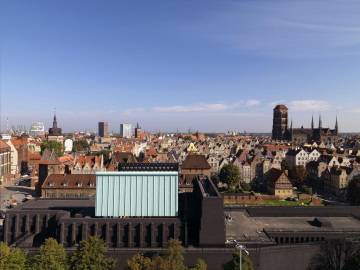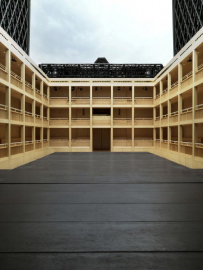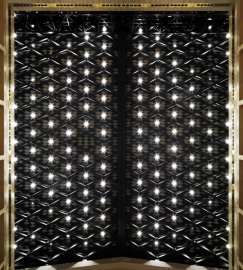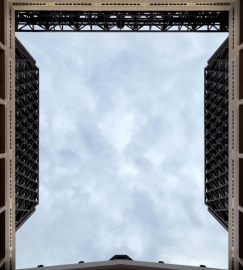The Gdańsk Shakespeare Theatre
Two concepts converge in the project: first, historical nature; second, political-
cultural nature.
Historically: the Baltic city had already known on the seventeenth century the wooden building of the Elizabethan Theatre. After about four centuries it builds the new theatre on the same place, but in an urban context completely different.
Politically: in 2004 Poland leaves Soviet Union and officially enters European Union. The same year of the new Elizabethan Theatre international competition. As if the new theatre should represent on the stage of Gdansk the reversal of political horizon.
Theatre building is divided formally and functionally into three main parts: 1 outer edges, 2 theatre, 3 administrative area.
1 Edges The outer edges are public passageways leading around the whole complex. This new pedestrian urban platform lies six metres above entrance level. The height offers a new viewpoint of historic and modern city with its contrasts and compositional counterpoints. Functionally, the edges ensure escape ways, and pedestrian links with all the levels of complex, including the basement (-5m).
2 Theatre
Outside
The theatres silhouette is characterized by three general aspects: volumes, masonry ribs, openable roof. From volumes profile two very distinct parts emerge. First belongs to the Elizabethan Theatre, and sets the high of the building to 12.00m. Second, the 18.00m high scenic-
tower. Technical and symbolic requirements make it the highest panoramic point. When the theatre roof is open, the view from the tower includes the theatres interior. Masonry ribs characterize the volumes of the theatre and scenic tower. On the outside, they indicate the rhythm of the modular indoor structure. They are needed to absorb the pressure that the roofs wings exert on the walls. Openable roof. It comes from typological and symbolic needs. The wings opened, reach 24m height, concluding the vertical scale of levels (6-12-18-24m). In plan, the whole assumes the figure of a diapason with the main axis oriented east-west. The scenic-
tower transversely divides theatre from administrative area. Its central position restricts the pathways of the outer pedestrian edges. Situated within the perimeter of the diapason (3.6m thick) are all the horizontal and vertical walkways. This figuratively autonomous part is distinguished from the edges precisely to express the spatial hierarchy between different formal systems. B- Inside
In contrast to gravity and compactness of outer walls, the interiors are in light wood of two types, one for the Elizabethan theatre, and one for the suspended foyer volume. The former, the typological module of 2.8x2.8x2.8m derives from archaeological excavations on site. In plan, six modules on two long sides and five on short one, make a C-shaped figure. 51 modules for 600 spectators. Wooden columns (25x25cm) contain a steel structure and are positioned in accordance with the modular pattern of the galleries. The Elizabethan and Italian stages are fully mechanized to meet the theatres configuration needs. The stages are mobile, almost in response to the wings of roof. In the foyer volume, a suspended box offsets the external masses. A double height room overlooks different voids distinguishing and enveloping the entry spaces, from the lower museum area to the galleries of the theatre. When wings open, the sun rays can extend until the basement.
3 Administrative area
It contains all secondary theatre activities. Two floors volume, with a roof terrace at the same level with the outer edges from which it is possible to access the square roof open to entire city. Another unexpected place for representations: stage third.
Stage fourth: the one that looks to the sky of Gdansk, the sky of Shakespeare, the inner sky of each of us.








